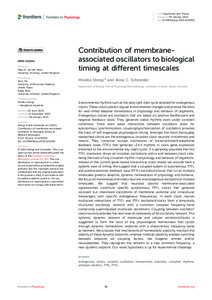Contribution of membrane-associated oscillators to biological timing at different timescales
| dc.date.accessioned | 2024-03-05T16:22:40Z | |
| dc.date.available | 2024-03-05T16:22:40Z | |
| dc.date.issued | 2024-01-09 | |
| dc.identifier | doi:10.17170/kobra-202403059720 | |
| dc.identifier.uri | http://hdl.handle.net/123456789/15529 | |
| dc.description.sponsorship | Gefördert durch den Publikationsfonds der Universität Kassel | |
| dc.language.iso | eng | |
| dc.rights | Namensnennung 4.0 International | * |
| dc.rights.uri | http://creativecommons.org/licenses/by/4.0/ | * |
| dc.subject | endogenous clocks | eng |
| dc.subject | coupled oscillators | eng |
| dc.subject | homeostasis | eng |
| dc.subject | plasticity | eng |
| dc.subject | circadian rhythms | eng |
| dc.subject | ultradian rhythms | eng |
| dc.subject | TTFL | ger |
| dc.subject | PTFL | ger |
| dc.subject.ddc | 570 | |
| dc.title | Contribution of membrane-associated oscillators to biological timing at different timescales | eng |
| dc.type | Aufsatz | |
| dcterms.abstract | Environmental rhythms such as the daily light-dark cycle selected for endogenous clocks. These clocks predict regular environmental changes and provide the basis for well-timed adaptive homeostasis in physiology and behavior of organisms. Endogenous clocks are oscillators that are based on positive feedforward and negative feedback loops. They generate stable rhythms even under constant conditions. Since even weak interactions between oscillators allow for autonomous synchronization, coupling/synchronization of oscillators provides the basis of self-organized physiological timing. Amongst the most thoroughly researched clocks are the endogenous circadian clock neurons in mammals and insects. They comprise nuclear clockworks of transcriptional/translational feedback loops (TTFL) that generate ∼24 h rhythms in clock gene expression entrained to the environmental day-night cycle. It is generally assumed that this TTFL clockwork drives all circadian oscillations within and between clock cells, being the basis of any circadian rhythm in physiology and behavior of organisms. Instead of the current gene-based hierarchical clock model we provide here a systems view of timing. We suggest that a coupled system of autonomous TTFL and posttranslational feedback loop (PTFL) oscillators/clocks that run at multiple timescales governs adaptive, dynamic homeostasis of physiology and behavior. We focus on mammalian and insect neurons as endogenous oscillators at multiple timescales. We suggest that neuronal plasma membrane-associated signalosomes constitute specific autonomous PTFL clocks that generate localized but interlinked oscillations of membrane potential and intracellular messengers with specific endogenous frequencies. In each clock neuron multiscale interactions of TTFL and PTFL oscillators/clocks form a temporally structured oscillatory network with a common complex frequency-band comprising superimposed multiscale oscillations. Coupling between oscillator/clock neurons provides the next level of complexity of an oscillatory network. This systemic dynamic network of molecular and cellular oscillators/clocks is suggested to form the basis of any physiological homeostasis that cycles through dynamic homeostatic setpoints with a characteristic frequency-band as hallmark. We propose that mechanisms of homeostatic plasticity maintain the stability of these dynamic setpoints, whereas Hebbian plasticity enables switching between setpoints via coupling factors, like biogenic amines and/or neuropeptides. They reprogram the network to a new common frequency, a new dynamic setpoint. Our novel hypothesis is up for experimental challenge. | eng |
| dcterms.accessRights | open access | |
| dcterms.creator | Stengl, Monika | |
| dcterms.creator | Schneider, Anna Caren | |
| dcterms.extent | 21 Seiten | |
| dc.relation.doi | doi:10.3389/fphys.2023.1243455 | |
| dc.subject.swd | Biorhythmus | ger |
| dc.subject.swd | Tagesrhythmus | ger |
| dc.subject.swd | Ultradianrhythmus | ger |
| dc.subject.swd | Homöostase | ger |
| dc.subject.swd | Oszillator | ger |
| dc.subject.swd | Zeitmessung | ger |
| dc.type.version | publishedVersion | |
| dcterms.source.identifier | eissn:1664-042X | |
| dcterms.source.journal | Frontiers in Physiology | eng |
| dcterms.source.volume | Volume 14 | |
| kup.iskup | false | |
| dcterms.source.articlenumber | 1243455 |
Dateien zu dieser Ressource
Das Dokument erscheint in:
-
Artikel [1109]


